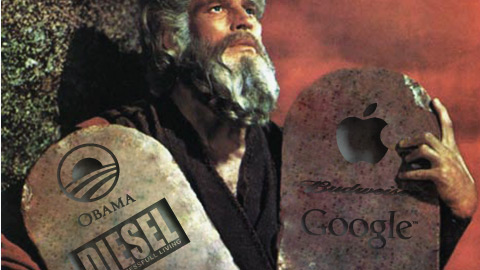… And 5 brands that stick to them

In Biblical times, your attention span was long enough for 10. Now you’ll have to make do with half. We took a slate and chiselled out these 5 commandments and the brands that live by them.
1. More looking at people, less reading of trend reports
Take a good look at your consumer and ‘the people’, not at what trend reports say you should be focused on. Reports like that desperately trail behind the consumer almost every time, because ‘the people’ circa 2013 decide for themselves what works and what doesn’t. They also decide which media channels get used for that.
Exemplary brand: Google.

Why: Google’s most recent marketing campaign is completely based on how people use their product, which in this case is the Internet. Their message: “The web is what you make it”, is based on that. They’ve also based the face of the campaign on how people use their product: Lady Gaga, the most googled person of all time.
2. Product is more important than ever
Putting out a huge campaign to make your product well known is fun, but what you really want is to have people saying good things about your product. Every consumer is a network and conversation amplifier rolled up in one. Knowledge of said network is important, but even more important is having a product good enough to talk about. Because who are the biggest growers in the Brand Top 100 this year? Names like Facebook, Baidu (the Chinese Google) and Apple: products that are used by a massive amount of people and whose name rolls over everyone’s tongue. This doesn’t mean that the marketing department should receive a smaller budget, but that it should be closely involved with the development department. It isn’t really about the quality of the product (how fast your laptop is, how tasty that sauce of yours is) but how well your product scores when it becomes the starting point of a story (how many people listen when you talk about that laptop at a dinner party, or how many people get excited when you serve them this sauce they’ve been hearing about). Trend guru Seth Godin created the ‘first ten’ rules for this: tell ten people you trust about your product or product innovation. If they aren’t into it, then you should seriously reconsider whether the rest of the world will be losing sleep over your future product. If you put out something that nobody is interested in, you shouldn’t be too surprised when no one wants to hear or talk about it.
Exemplary Brand: Budweiser.

Why: Budweiser’s slogan is “This Bud’s for you”. So the Bud marketing boys developed this new technique where you can scratch your own name into a Bud bottle’s label. That way no one can confuse ‘your’ Bud with ‘their’ Bud. A near perfect combination of improving a consumer’s experience (nobody can snatch your beer from you), fortifying the existing brand positioning and creating that highly coveted ‘conversation buzz’. While other brands try their luck by using online campaigns to infiltrate the virtual conversation, Budweiser just changes something simple about the product (the packaging) which automatically works its way into the consumer’s conversations (both online and offline).
3. Don’t fear innovation
Brands’ head honchoes often want innovation in their communication and brand positioning, but those people are hard to reach most of the time. They’re being shielded from new propositions by the people whose main interest is improving their own position by playing it safe. But there’s a real danger of losing the consumer when a brand doesn’t evolve with them.
Exemplary brand: Barack Obama.

Why: Obama’s speechwriter is yet to turn thirty and is part of the Facebook generation. The most famous campaign image of Obama was made by a street artist who would illegally tag New York buildings. Go ahead; try selling innovation like that to a room full of account or marketing managers.
4. The execution is more important than the plan
He who still draws up a five-year brand communication plan should stop and think about this: five years ago we didn’t have an iPad or iPhone and Facebook was only a start-up of a few hundreds of thousands of dollars. Long-term thinking is a good thing, especially when you’re talking brand building. But plans that have to go through too many commissions risk becoming diluted and hopelessly dated. Brand guarding and strategy help keep communication clear and strong, not postponed and watered down.
Exemplary brand: Apple.

Why: Apple figured out years ago that, for instance, an iPod’s package doesn’t need an overload of ‘on brand messaging’. Instead of having a commission telling them what to communicate, they had faith in their product and kept the POS communication clear and simple. The practical development of the packaging came before ‘what should be put across’ according to the theory of brand strategy, without the two aspects butting heads.
5. Follow technology
The future of marketing has never been more attached to technology. If you want to stay relevant, you have to be able to keep up without discarding new developments as ‘hypes’. All of this is nothing new, the Mad Men of the sixties were already looking down on ‘those crazy new TV departments’.
Exemplary Brand: Diesel.

Why: Brands can go after two kinds of success on Facebook: they can collect a lot of ‘likes’ or really start up a dialogue with their consumers. Diesel picked the first strategy: they took their ‘like’ system offline and put it in their POS-channel. Customers who see a pair of jeans they like in the stores can scan a code with a QR-app and automatically like those jeans on Facebook.
Now go about thy day and telleth these words wherever they can be of use.




